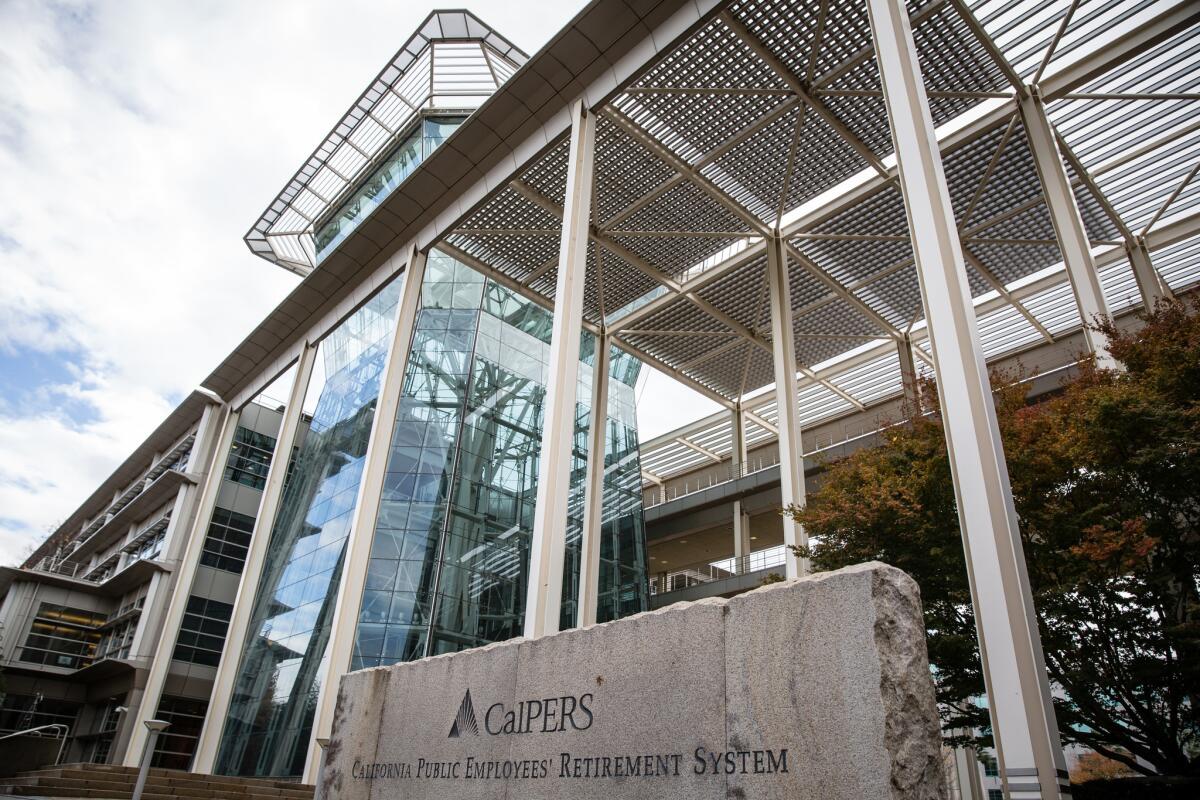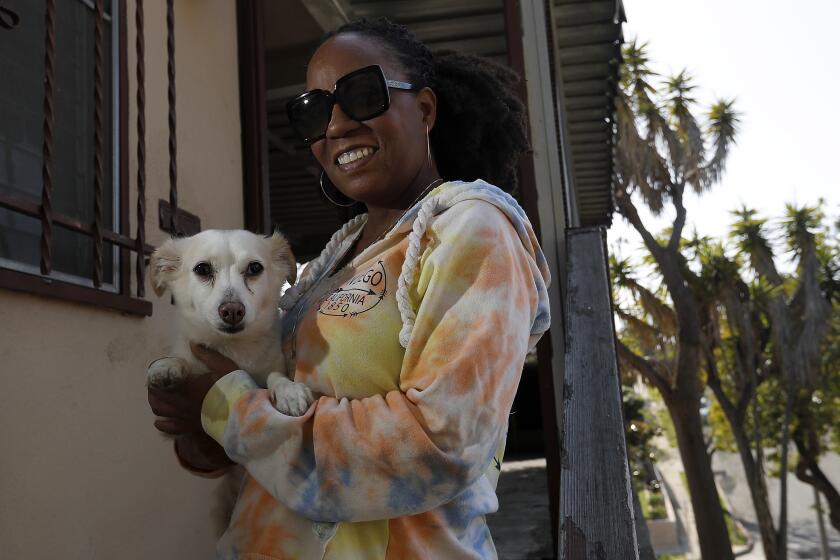Calpers gave up a $1-billion payday by scrapping a hedge against a stocks crash

Three years ago, the largest U.S. pension fund made an unusual investment. It bought so-called tail-risk protection, a kind of insurance against financial catastrophe. In a market meltdown like the one sparked by the coronavirus, the strategy promised a massive payout — more than $1 billion.
If only the California Public Employees Retirement System had stuck with the plan. Instead, CalPERS removed one of its two hedges against a bear market just weeks before the viral outbreak sent stocks reeling, according to people familiar with its decision.
The timing couldn’t have been worse. The fund had incurred hundreds of millions of dollars in premium-like costs for those investments. Then it missed out on a bonanza when disaster finally struck.
Softening the blow, CalPERS held on to the second hedge long enough to make several hundred million dollars, one of the people said.
“It becomes hard to establish and hold these hedges because they eat away at precious returns. Pension funds have return targets that are highly unrealistic.”
— Dean Curnutt, Macro Risk Advisors
Ben Meng, chief investment officer of CalPERS, said the fund terminated the hedges because they were costly and other risk-management tools are more effective, cheaper and better suited to an asset manager of its size.
“At times like this, we need to strongly resist ‘resulting bias’ — looking at recent results and then using those results to judge the merits of a decision,” Meng said in a statement. “We are a long-term investor. For the size and complexity of our portfolio, we need to think differently.”
CalPERS had been warned about the perils of shifting strategy. At an August 2019 meeting of its investment committee, Andrew Junkin, then one of the pension plan’s consultants at Wilshire Associates, reviewed the $200 million of tail-risk investments.
“Remember what those are there for,” Junkin told CalPERS executives and board members, according to a transcript. “In normal markets, or in markets that are slightly up or slightly down, or even massively up, those strategies aren’t going to do well. But there could be a day when the market is down significantly, and we come in and we report that the risk-mitigation strategies are up 1,000%.”
Sure enough, the position CalPERS gave up generated a 3,600% return in March. The costly flip-flop demonstrates the pitfalls of trying to time stock-market hedging. Like many insurance products, tail-risk protection seems expensive when you need it least.
That’s especially true at a pension fund. CalPERS tries to generate an annual return of 7% on its investments, leaving little room for error at a time when risk-free rates are close to zero. This kind of bear-market hedge can cost $5 million a year for every $1 billion protected, said Dean Curnutt, chief executive of Macro Risk Advisors, which devises risk-management strategies for institutional investors.
“It becomes hard to establish and hold these hedges because they eat away at precious returns,” Curnutt said. “Pension funds have return targets that are highly unrealistic.”
Calpers, based in Sacramento, manages about $350 billion to fund the retirement benefits for some 2 million state employees, including firefighters, librarians and garbage collectors. When the pension plan doesn’t meet its 7% target, taxpayers may have to kick in more money to make sure there’s enough to meet its long-term obligations.
Half of CalPERS’ assets are in stocks, and historically it has tried to blunt the effects of market downturns by investing in bonds, real estate, private equity and hedge funds. Over the last 20 years, the portfolio has returned 5.8% annually, compared with 5.9% for the S&P 500 and about 4.6% for an index of Treasuries.
In 2016, then CalPERS Chief Investment Officer Ted Eliopoulos asked his staff to investigate ways to protect its stock holdings from crashes such as those in 1987, 2001 and 2008, according to the people familiar with the fund. He’d been inspired by Nassim Taleb, the former options trader who wrote about the probabilities of rare but devastating events in his 2007 bestseller “The Black Swan.”
Showrooms are closed, but many car dealers sell online, with delivery to your door.
The year after the book was published, Lehman Bros. went bankrupt, stocks imploded and the global economy seized up. CalPERS reported a 23% loss in 12 months, and Taleb became a celebrity.
Tail-risk hedging evolved from probability theory. In statistics, the fat belly of a bell curve represents events that are likeliest to occur while the skinny tail ends indicate those that are possible but infrequent, such as a collapse in financial markets.
In 2017, CalPERS hired two outside fund managers to provide tail-risk protection. Universa Investments, a Miami firm advised by Taleb, provided the potentially more profitable hedge; LongTail Alpha in Newport Beach, the second one.
The investments, initially small and exploratory, quadrupled in size over the next two years. They ultimately safeguarded the pension plan against losses on several billion dollars, the people familiar with the situation said.
The program wasn’t cheap. CalPERS calculated that in the year that ended June 30, the Universa and LongTail Alpha investments reduced its 12-month return by a total of 0.04 percentage points, or roughly $140 million.
Some of the hedging expense was management fees. Public filings show CalPERS paid Universa $22.5 million and LongTail Alpha $3.2 million that year. The remaining cost reflected the declining value, or bleed, of the underlying positions at a time of low market volatility.
At its peak, the Universa hedge was enough to protect some $5 billion of CalPERS’ $200 billion in public equities, and Eliopoulos had plans to double the program’s size, the people said. It’s unclear how extensive the LongTail Alpha position was.
Most institutional investors prefer a more traditional approach to risk management, such as diversifying assets and holding Treasuries. Insurance is harder to grasp, and fund managers typically balk at the idea of investing in anything that loses money most of the time, Macro Risk Avisors’ Curnutt said.
“Tail-risk hedging does work,” Curnutt said. “But the price matters quite a bit.”
The payoffs can be staggering. In an April 7 letter to clients, Universa said its fund returned 3,612% in March. CalPERS could have used that windfall of more than $1 billion to buy more stocks at lower prices or stayed in cash.
The housing market has taken a hit as the coronavirus has spread. However, some buyers are still moving forward.
Eliopoulos left CalPERS in late 2018 and joined Morgan Stanley as a vice chairman. He declined to comment.
Meng, a former Wall Street trader, was skeptical of tail-risk hedging and ordered a review of the program as part of a wider effort to reduce the number of outside asset managers that CalPERS paid, the people familiar with the situation said. A number of his subordinates argued in favor of keeping the hedges in place, saying it was only a matter of time before the 10-year bull market in stocks came to an end, the people said.
They lost the battle, and CalPERS moved to redeem its tail-risk investments. It gave notice to Universa in October and by January no longer had the position in place that would have paid out more than $1 billion, according to those with knowledge of the decision.
LongTail Alpha persuaded Meng to hold on longer, and fortunately he did. Because that hedge wasn’t terminated until March 31 — after the stock-market rout — CalPERS was able to reap several hundred million dollars.
More to Read
Inside the business of entertainment
The Wide Shot brings you news, analysis and insights on everything from streaming wars to production — and what it all means for the future.
You may occasionally receive promotional content from the Los Angeles Times.












